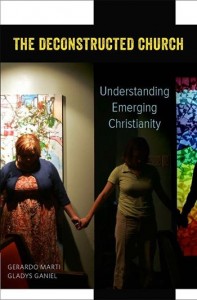 The latest issue of Christian Century (December 24, 2014, V131, N26) features a review of my new book, co-authored with Gerardo Marti, The Deconstructed Church: Understanding Emerging Christianity (Oxford, 2014).
The latest issue of Christian Century (December 24, 2014, V131, N26) features a review of my new book, co-authored with Gerardo Marti, The Deconstructed Church: Understanding Emerging Christianity (Oxford, 2014).
The review is written by William H. Willimon, the highly respected professor of the practice of Christian Ministry at Duke Divinity School. Many will know Willimon as a co-author, with Stanley Hauerwas, of the classic Resident Aliens: Life in the Christian Colony (1989). His books have sold more than a million copies.
You can read the full review on my academia.edu profile.
Willimon’s review opens with this summary of our book:
‘In The Deconstructed Church, two veteran sociologists of religion give us our most extensive, comprehensive, and revealing ethnographic study of the worldwide phenomenon known as the emerging Christian movement, or as they abbreviate it, the ECM. Though so-called emerging Christians despise definitions and generalizations about themselves, the authors begin with a helpful definition: “The ECM is a creative, entrepreneurial religious movement that strives to achieve social legitimacy and spiritual vitality by actively disassociating from its roots in conservative, evangelical Christianity.”
… Though ECM congregations do not yet account for a significant segment of Christianity, they may be the most fascinating, fresh development in the church for our time and our area of Christendom.’
Willimon’s review also is informed by his experience as a pastor and bishop in the Methodist Church. This perspective added a freshness and immediacy to his review, which is not often found in reviews of books in academic journals. Some examples of his comments include:
‘In many ways, this is a very hopeful book. I, who often lament the stolid, ossified nature of my own church, found it an invigorating reminder that the church can be one of the most adaptive, supple institutions in history in its fluid, deconstructing, reconstructing inventiveness. And yet this book is also a bit scary to a bishop like me who was produced by and has spent my life serving the church that the ECM means to deconstruct.
… I really tried to read this book with as much generosity as I could muster, overlooking the fact that I am a representative of the type of church the ECM is out to defeat. And yet I join with Marti and Ganiel in asking whether in its deconstruction, the ECM is constructing anything of lasting value. It may succeed at being a counter to the institutional church, but can it be sure that it’s not just the latest phase of Western Christianity’s capitulation to culture? Just as United Methodism has institutionalized some of the pathologies of my generation, isn’t it possible that the ECM will institutionalize the cultural captivity of the limited world of twenty- and thirtysomethings?’
Willimon includes our conclusion that ‘the ECM is more than a passing fad,’ but echoes a question we also raise: ‘How are they going to keep this thing going?’
He explains how a young ECM congregation has recently attached itself to his own congregation, in part because it did not have the resources for childcare provision and ‘wanted to hitch on to our church’s extensive mission involvement rather than begin their own.’ Willimon leaves us with this possibility:
‘Perhaps there is a possibility that the old mainline and the new ECM will mesh in some way after all.’